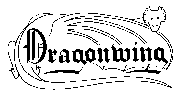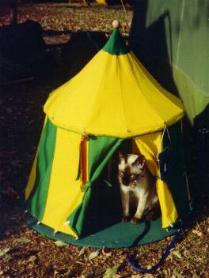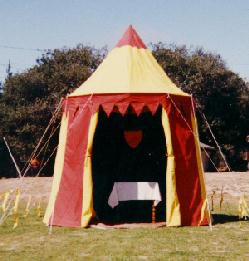

But by the time I'd accepted my sister-in-law's invitation, the SCA's West Kingdom had been camping out in tents and creating passable imitations of medieval pavilions, for some time. I'd been impressed by some of the efforts I'd seen. I had, at that point, been a professional sailmaker for about fifteen years and knew a bit about putting pieces of cloth together. My particular speciality was aviation sailmaking, or the manufacture of the fabric components of hang gliders and ultralights. This was the most demanding sort of sailmaking around, because it required great precision and attention to detail. (A hang glider sail can actually be thought of as two sails, one for the left wing and one for the right wing; if these two sails are not absolutely identical, the wings will perform differently and the glider will not fly straight.) By virtue of my employment with some of the industry's biggest and most innovative manufacturers, I had been lucky enough to be able to help sailcloth makers design fabrics specifically for the aviation industry, and to design gliders using various finishes of cloth in specific parts of the glider to maximize performance and longevity.
After fifteen years of having fabric on my mind, it wasn't long before I was looking at SCA tentage with a more critical eye. Most of what I saw was made with fabric that wasn't really designed for tents, stretched over rigid metal frames. The tents weren't very waterproof, which usually wasn't a problem in California summers but could cause consternation at those events in the spring and fall when the rain gods wanted to assert their presence. I realized that I could make better tents than the ones that were available, and wondered if there was a market for them.
My first step was research. I spent hundreds of hours in libraries researching what medieval tentage looked like, and how they might have been put together. On the basis of this research, I designed two pavilions and made models of them in one-sixth scale. What little market research I did indicated that people wanted tents without center poles, so I designed a frame that didn't use one. It relied instead on a series of perimeter poles supporting a "spider" network of poles that in turn supported a false center pole. I had based it on a description of a similar tent in the SCA's Known World Handbook, but mine incorporated a method of tensioning the false center-pole to keep the canopy fabric tight. The design was clumsy, but workable.
I next researched the material that I would use. One of my first discoveries was that, according to California state law, the tents had to be made of a flame-retardent fabric that conformed to specifications laid out by the California Fire Marshall. This immediately eliminated about 90% of the tentage I had intended to use. Of the remaining 10%, only a few met my other requirements: that the material have the look and feel of woven fabric, that it be sufficiently durable for me to offer a five-year warranty, and that it be affordable enough that my tents weren't to be immediatey priced beyond the means of my customers.

The models were made over Thanksgiving and were ready to display at the SCA's West Kingdom Twelfth Night coronation, where they were used in my exhibit booth. Later, both models were used in various classes on tentmaking as visual aids, and finally were donated to the West Kingdom's Land Fund to be auctioned off at their annual fund-raising event. One saw service subsequently as a "cat house" for Squire Harry, a cat often taken to events by his owner. This tent inspired an entire line of furnishings in the same one-sixth scale, including a banner, a rope bed, and a fire-pit. Most recently, the tent has been occupied by Barbie dolls, who fit the scale perfectly.
 With some interest raised in my new business, I made a full-size, 10' version of the round tent and set it up at March Crown Tourney, where it shrugged off the event's rain and snow and did pretty much everything I expected it to do. Enough orders followed to ensure the success of the business, and I located a four-ounce Dacron cloth that showed great promise as an affordable tent fabric. Several tents were made (all in combinations of blue, grey, maroon, and green -- the only colors the fabric was available in) before the cloth's manufacture was discontinued a few months later. I was sorry to see it go, because it was the only light-weight cloth that really worked for larger tents. (I made tents later using a four-ounce Nylon for the sides, but that fabric wasn't suitable for the roofs and wasn't dimensionally stable at varying temperatures, and I no longer recommend any form of Nylon as a tent material.) For fabric, I came to rely on canvas made specifically for tents and awnings. Although heavier than all-cotton canvases, I found that it lasted far longer, came already treated for fire-retardence (and mildew resistence and water-repellance as well) and was available in a wide range of colors. This fabric has been my mainstay ever since, although I've used just about every other canvas fabric on the market at one time or another for different designs and purposes.
With some interest raised in my new business, I made a full-size, 10' version of the round tent and set it up at March Crown Tourney, where it shrugged off the event's rain and snow and did pretty much everything I expected it to do. Enough orders followed to ensure the success of the business, and I located a four-ounce Dacron cloth that showed great promise as an affordable tent fabric. Several tents were made (all in combinations of blue, grey, maroon, and green -- the only colors the fabric was available in) before the cloth's manufacture was discontinued a few months later. I was sorry to see it go, because it was the only light-weight cloth that really worked for larger tents. (I made tents later using a four-ounce Nylon for the sides, but that fabric wasn't suitable for the roofs and wasn't dimensionally stable at varying temperatures, and I no longer recommend any form of Nylon as a tent material.) For fabric, I came to rely on canvas made specifically for tents and awnings. Although heavier than all-cotton canvases, I found that it lasted far longer, came already treated for fire-retardence (and mildew resistence and water-repellance as well) and was available in a wide range of colors. This fabric has been my mainstay ever since, although I've used just about every other canvas fabric on the market at one time or another for different designs and purposes.
I eventually gave up on the no-center-pole design. Although it did what it was supposed to do, it required much more in the way of structure than its replacement, which consisted of a center pole and a ring (and, later, a single side pole to stabilize the windward side of the tent). I gradually realized that the center pole wasn't really much of an obstruction, particularly in the larger tents. So my own tents were converted over to the center-pole design.
For the first five years, Dragonwing tents did not include the frame, which I expected customers to build themselves, thereby saving some shipping money. The tent came with instructions on how to build both types of frames, but I'd wager that most of them ended up with the center-pole and ring design. When Dragonwing began offering frames for all of its tents, the ring system was the only one provided.
A line of oval tents was introduced during Dragonwing's second year, after many frame configurations had been tried and discarded. In my quest to avoid having to lug around a truckful of perimeter poles, and ended up with a version that, with many refinements, is the one we use today. This design uses six perimeter poles, two eave poles under the flat portions of the roofs, and steel ring segments to support the curved portions of the roof. The only tool required is the hammer you use to drive the stakes into the ground.
I still remember one event where I tried to support the perimeter of the roof with lath sections about 3/8" thick and 1-1/2" wide. The setup worked fine in still air, but it proved to be more than a handful when the wind picked up when I pitched the tent at the site of the event. The wind would catch the still-unguyed roof, bending it into a variety of weird and wonderful configurations and overstressing the lath support, which snapped with a sound like a rifle shot. Dukes Frederick of Holland and James Greyhelm watched the whole affair with great amusement. Eventually I gave up, drove to my shop a few miles away, and came back with a conventionally framed round tent. The oval frame would undergo a few more permutations (including one that bolted together) before I deemed it fit for inclusion in the instruction sheet that came with the tent.
Along with making tents for fun and profit, I have been active in teaching people how design and build their own. It's always been a pleasure to see a student use what he or she has gleaned in my class to design a tent that meets its owner's specific needs. I've taught tent-making at various West Kingdom events, at the Twenty Five Year Celebration, and the Thirty Year Celebration. These classes are valuable to me not only for what I've taught, but for what I've learned from others on what works and what doesn't. I've decided that nobody knows it all, but everybody knows a little something that somebody else doesn't know. That's what makes the tentmaking classes worthwhile for me and my students.
Everybody likes to talk about their success, but nobody likes to talk about difficulties. The reason I've mentioned some of my false starts here (and the reason Steve Peck mentioned some of his in last month's column) is to reassure you that some mistakes are likely to crop up in the design process, but that very few of them are serious, and all of them teach something. If your reason for not designing and making your own tent is that you're not sure you can pull it off flawlessly, remember that even less-than-perfect tents usually work just fine, and that your next one (whether you make it or buy it) will be better because of what you've learned in making the first one.
Have at it!